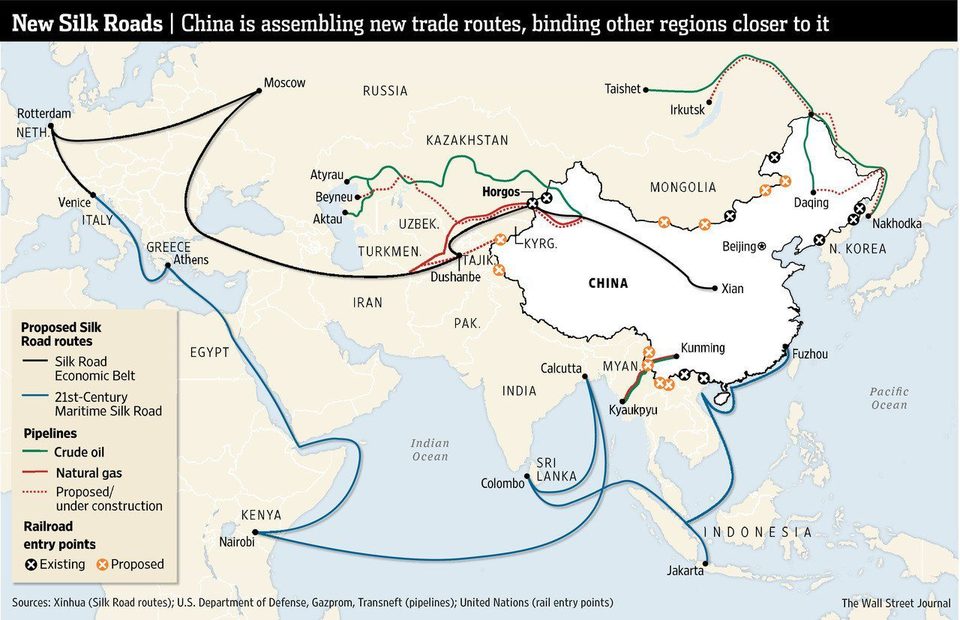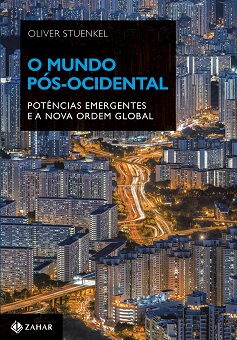
Review: The Emerging Political Economy of OBOR. The Challenges of Promoting Connectivity in Central Asia and Beyond. A Report of the CSIS Simon Chair in Political Economy. By Alexander Cooley. October 2016. Full report available here.
——–
In September 2013 at Nazarbayev University in Astana, Kazakhstan, Chinese president Xi Jinping announced that China would fund a New Silk Road Economic Belt (usually referred to as OBOR) across Eurasia to connect China with Europe, the Middle East, and South Asia. Media estimates investment in OBOR at between $800 billion and $1 trillion, covering 890 projects in over 60 partner countries — a truly monumental initiative. Several commentators have made parallels between OBOR and the U.S.- sponsored Marshall Plan that aided in the reconstruction of postwar Europe.
Xi’s OBOR initiative serves a dual purpose. Domestically, he hopes that better transport links will promote growth in underdeveloped central and western regions such as Xinjiang, Gansu Province, Ningxia, Guangxi and Yunnan Province. That would not only boost overall GDP, but also reduce regional economic inequality, and thus migration into the coastal areas, a trend that may contribute to social tension. An economic boom in Xinjiang is also seen as the best way to combat the rise of Islamic extremism in the region.
From a foreign policy perspective, the most immediate goal of the OBOR initiative is to boost China’s influence in Central Asia, a resource-rich region that no longer falls into Moscow’s orbit. As a growing number of countries becomes dependent on Chinese transport and energy infrastructure, stronger economic ties will make it increasingly costly for Central Asian governments to oppose China.
Different from the ancient Silk Road, which mainly focused on trade, the “One Belt and One Road” could also include the flow of financial services, information, technology and people. China will involve its neighbors in a series of institutional setups – such as the Asian Infrastructure Investment Bank (AIIB), the CICA security architecture, and corridors through Pakistan and Myanmar to the Indian Ocean that may, in the medium term, contribute to the creation of a increasingly sinocentric Asia.
According to China’s Foreign Minister Wang Yi, 2015 was crucial in promoting and carrying out the “Belt and Road” initiatives:
The ‘Belt and Road’ initiative will not only focus on infrastructure to physically connect [these countries], but also to explore free trade agreements.
Western analysts often point out that China is likely to encounter strong resistance to its plan to strengthen connectivity both on land and sea. Among others, resurgent Russia and a more ambitious India are supposedly eager to block Beijing’s schemes. While such a possibility indeed exists, Chinese roads and ports could also be welcomed with open arms by those who rightly see them as a chance to boost economic development and connectivity.
Seeking to test these assumptions, Alexander Cooley, a professor at Columbia University, assesses, in a highly informative report for the Center for Strategic and International Studies, how Chinese-led projects will interact with local political agendas, social conditions, and networks across different regions. He divides most analysts into “Gamers” (who focus on geopolitical implications) and “Traders” (who look for economic opportunities), but says that few analyses focus on the political economy of OBOR and how it is likely to play out in Central Asia, one of the most volatile regions on earth.
As the author points out, Beijing’s role in the region changed dramatically in the 2000s: China became Central Asia’s most important trading partner, and Beijing turned into the region’s main external creditor. During the financial crisis, China extended loans for energy agreements worth $8 billion to Turkmenistan and $13 billion to Kazakhstan, making it a de facto lender of last resort and regional development assistance provider.
Cooley questions the common assumption that greater investment in the region will promote economic development, political stability and, most importantly, pro-China sentiment. He shows how, in several instances, China’s growing clout has led to instability and anti-China movements. In Pakistan, he points out, Chinese projects (mining and construction) and workers have been attacked by Baloch rebels and have become embroiled in separatist struggles with the Pakistan government. As the Financial Times recently reported, China’s diplomats have taken the unprecedented step of intervening in Pakistan’s complex domestic politics to ensure the smooth passage of its $45bn investment in infrastructure projects as part of OBOR. The risks involved are immense, particularly when considering China’s limited experience in such matters: “It is precisely on this issue that Beijing faces two potential major challenges in Central Asia: growing Sinophobia and regional ethnic and social divisions”, the author states.
The second major set of challenges in Central Asia, according to the report, is how OBOR will affect governance and corruption in the region. Cooley writes that
The “development equals stability” equation emphasizes almost exclusively on the “hardware” of development, but it ignores the “software” that is necessary for development—namely how to overcome problems of graft, informal barriers, and rent- seeking that plague the region.
Astonishingly, Chinese officials privately expect to lose 80 percent of their investments in Pakistan, 50 percent in Myanmar, and 30 percent in Central Asia — a kind of investment “leakage” difficult to avoid. Yet as Cooley convincingly argues, the inflow of Chinese money could worsen corruption, particularly in the realms of privatizations, private-public partnerships. That could, at some point, fuel anti-China sentiments, provided that observers regard China as a negative influence. But more importantly, due to bad governance in the region, there is no evidence that OBOR projects will reduce cross-border transaction costs.
Commenting on the report, Catherine Putz writes for The Diplomat that “offers a refreshing dash of lukewarm water on the hype surrounding China’s visionary trans-Asian infrastructure development scheme.” Indeed, for those who hope that OBOR will transform and modernize Central Asia, the report will be somewhat disappointing.
Policy makers in Beijing will regard it as a useful warning. While they care more about stability and less about good governance, it shows that operating in Central Asia requires sophisticated on-the-ground knowledge to avoid the emergence of anti-China sentiments.
Considering that China is the world’s second largest economy and no.1 trading partner of many countries around the world, anti-China sentiment is still remarkably limited. And yet, as Chinese investments will enhance its political influence, politicians around the world will be tempted to identify China as a scape goat. Beijing’s challenge in Central Asia will be to assure that OBOR is seen by both elites and the population as a win-win situation. Only if it succeeds will its pivot to Eurasia cement, rather than undermine, China’s regional leadership claims.
Read also:
Return of a King: The Battle for Afghanistan, 1839-42
The Shanghai Cooperation Organization expands into South Asia








